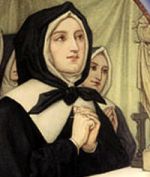Padua's Prophet
by Rev. Vincent F. Kienberger, O.P.
Many people of Padua, Italy, seldom refer to their patron, St. Anthony, by his religious name. He is usually designated as "Il Santo"—"the Saint" par excellence, for it was this miracle-worker who raised Padua out of the obscurity of the other Italian cities and placed it upon a pinnacle of renown. In point of fact, however, the Saint's world-wide popularity has seemingly obscured his personality.
A traveler recently wrote an essay, "A Visit to Padua's Saint without a Name." In this article the author states that when a pilgrim arrives in Padua and asks a taxi-driver where the Church of St. Anthony is located, he is perplexed. Paduans have so personalized the sanctuary where the body of the holy friar lies entombed that they simply call the Basilica itself "Il Santo." By so doing they have clothed a building of stone and mortar with life and personality. However, if the client of the wonder-worker asks merely for the Basilica del Santo, voluminous directions are forthcoming from cabdriver or local merchant with an added homily on the life story of their foremost citizen.
Padua's Saint was born at Lisbon, Portugal, August 15, 1195. His parents, Martin Bouillon and Theresa Tavejra were noble folk. He was born on the feast of the Assumption, given the name of Ferdinand at baptism and consecrated to the Blessed Mother. Educated by the Augustinian monks, he later joined their community and was ordained a priest. For eight years he dwelt at Coimbra where he developed his excellent understanding and prodigious memory.
In 1220, Father Ferdinand witnessed the transfer of the bodies of the first five Morocco martyrs of the Franciscan Order to his abbey chapel of the Holy Cross. He was so stirred that he determined to follow in their footsteps to preach to the Saracens and to die for the Faith. Given the necessary permission, Father Ferdinand was clothed in the habit of St. Francis and received a new name, Friar Anthony. He landed in Morocco, but was forced home by illness. During a storm his ship sought refuge in a Sicilian port. From there he journeyed to Bologna and finally to Padua. A great preacher and a champion of social justice, his sermons were steeped in the Scriptures and in the writings of the Fathers. He foretold future events and was hailed as a prophet of the Most High. His apostolic work in combating heresy merited the title, "Hammer of the Heretics." He died at Vercelli, June 13, 1231, and was canonized May 30, 1232, by Pope Gregory IX.
This item 6118 digitally provided courtesy of CatholicCulture.org






